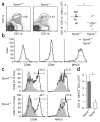The calcium-activated nonselective cation channel TRPM4 is essential for the migration but not the maturation of dendritic cells
- PMID: 18758465
- PMCID: PMC2956271
- DOI: 10.1038/ni.1648
The calcium-activated nonselective cation channel TRPM4 is essential for the migration but not the maturation of dendritic cells
Abstract
Dendritic cell (DC) maturation and migration are events critical for the initiation of immune responses. After encountering pathogens, DCs upregulate the expression of costimulatory molecules and subsequently migrate to secondary lymphoid organs. Calcium (Ca(2+)) entry governs the functions of many hematopoietic cell types, but the role of Ca(2+) entry in DC biology remains unclear. Here we report that the Ca(2+)-activated nonselective cation channel TRPM4 was expressed in and controlled the Ca(2+) homeostasis of mouse DCs. The absence of TRPM4, which elicited Ca(2+) overload, did not influence DC maturation but did considerably impair chemokine-dependent DC migration. Our results establish TRPM4-regulated Ca(2+) homeostasis as crucial for DC mobility but not maturation and emphasize that DC maturation and migration are independently regulated.
Figures







Similar articles
-
Fundamental Ca2+ signaling mechanisms in mouse dendritic cells: CRAC is the major Ca2+ entry pathway.J Immunol. 2001 May 15;166(10):6126-33. doi: 10.4049/jimmunol.166.10.6126. J Immunol. 2001. PMID: 11342632
-
Increased IgE-dependent mast cell activation and anaphylactic responses in mice lacking the calcium-activated nonselective cation channel TRPM4.Nat Immunol. 2007 Mar;8(3):312-20. doi: 10.1038/ni1441. Epub 2007 Feb 11. Nat Immunol. 2007. PMID: 17293867
-
TRPM4 links calcium signaling to membrane potential in pancreatic acinar cells.J Biol Chem. 2021 Sep;297(3):101015. doi: 10.1016/j.jbc.2021.101015. Epub 2021 Jul 27. J Biol Chem. 2021. PMID: 34329682 Free PMC article.
-
TRPM4.Handb Exp Pharmacol. 2014;222:461-87. doi: 10.1007/978-3-642-54215-2_18. Handb Exp Pharmacol. 2014. PMID: 24756717 Review.
-
Ca2+ signaling in the regulation of dendritic cell functions.Am J Physiol Cell Physiol. 2011 Jun;300(6):C1205-14. doi: 10.1152/ajpcell.00039.2011. Epub 2011 Mar 30. Am J Physiol Cell Physiol. 2011. PMID: 21451105 Review.
Cited by
-
Space exploration by dendritic cells requires maintenance of myosin II activity by IP3 receptor 1.EMBO J. 2015 Mar 12;34(6):798-810. doi: 10.15252/embj.201489056. Epub 2015 Jan 30. EMBO J. 2015. PMID: 25637353 Free PMC article.
-
Maturation of monocyte derived dendritic cells with OK432 boosts IL-12p70 secretion and conveys strong T-cell responses.BMC Immunol. 2011 Jan 5;12:2. doi: 10.1186/1471-2172-12-2. BMC Immunol. 2011. PMID: 21208424 Free PMC article.
-
TRPM4 inhibition promotes angiogenesis after ischemic stroke.Pflugers Arch. 2014 Mar;466(3):563-76. doi: 10.1007/s00424-013-1347-4. Epub 2013 Sep 17. Pflugers Arch. 2014. PMID: 24043570
-
TRP Channels Interactome as a Novel Therapeutic Target in Breast Cancer.Front Oncol. 2021 Jun 10;11:621614. doi: 10.3389/fonc.2021.621614. eCollection 2021. Front Oncol. 2021. PMID: 34178620 Free PMC article.
-
The TRP channels serving as chemical-to-electrical signal converter.Physiol Rev. 2025 Jul 1;105(3):1033-1074. doi: 10.1152/physrev.00012.2024. Epub 2025 Jan 15. Physiol Rev. 2025. PMID: 39813402 Free PMC article. Review.
References
-
- Steinman RM, Hawiger D, Nussenzweig MC. Tolerogenic dendritic cells. Annu. Rev. Immunol. 2003;21:685–711. - PubMed
-
- Bonasio R, von Andrian UH. Generation, migration and function of circulating dendritic cells. Curr. Opin. Immunol. 2006;18:503–511. - PubMed
-
- Banchereau J, Palucka AK. Dendritic cells as therapeutic vaccines against cancer. Nat. Rev. Immunol. 2005;5:296–306. - PubMed
-
- Naik SH. Demystifying the development of dendritic cell subtypes, a little. Immunol. Cell Biol. 2008;86:439–452. - PubMed
-
- Lewis RS. Calcium signaling mechanisms in T lymphocytes. Annu. Rev. Immunol. 2001;19:497–521. - PubMed
Publication types
MeSH terms
Substances
Grants and funding
LinkOut - more resources
Full Text Sources
Other Literature Sources
Molecular Biology Databases
Miscellaneous

